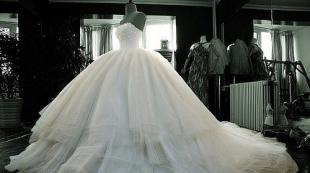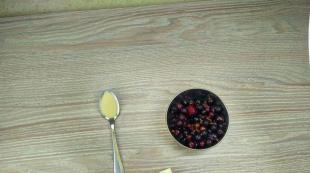Stark degree of comparison is German. Degrees of comparison of simple adjectives
German adjectives, indicating quality,(and also adverbs)in Germanhave three degrees of comparison:
—
positive(der Positive) :
dick (thick)
- comparative
(der Komparativ) :
dick er(thicker)
- excellent(der Superlativ) :
am dick sten (der dick ste) (the thickest)
The basic form of an adjective is the positive degree. It names the quality of an object without comparison, to this extent adjectives are given in the dictionary.
The positive degree serves as the basis for the formation of the other two degrees of adjectives.
comparative
The comparative form is formed by adding the suffix -er to the short form of the adjective and shows that this feature is inherent in some object or phenomenon to a greater extent than another:
klein - kleiner, laut - lauter, alt - älter,groß— größer
When forming the comparative and superlative degrees of comparison, most monosyllabic adjectives with root vowels -a, -o, -u accept umlaut:
alt - älter - am ältesten
groß - größer - am größten
jung- junger- am Jungsten
DerBruderist ä lter alsSchwester - Brother is older than sister
DieseSchuleist größ er alsunserHaus — This school is bigger than our house.
Ihr ä lterer Bruder —Her older brother
Seine jü ngere Schwester — His younger sister
The comparative degree of adjectives in a sentence can be used:
as a nominal part of the predicate
Dieses Bild ist schöner. — This picture is more beautiful (more beautiful).
Jenes Gebäude ist kleiner. — That building is smaller.
as a definition. In this case, the adjective comes before the noun and is declined like an adjective in the positive degree. Those. to the comparative degree (to -er), taken as a basis, the usual endings of adjectives are added:
DortscheinteinehellereLampe . — There is a brighter light there.
Wir suchen eine kleinere (größere) Wohnung. - We are looking for a smaller (larger) apartment.
Ich brauche ein en billigere n Computer. - I need a cheaper computer (the article has changed).
If a comparative adjective is followed by a comparison, then the conjunction is used als:
Dein Koffer ist leichter als meiner - Your suitcase is lighter than mine.
The comparative degree of adjectives can also be strengthened by adverbs such as viel (much, much), immer (here: everything), noch (yet), bedeutend (significantly).
Die Tage wurden immer k ürzer. — The days were getting shorter.
DieserSportleristjetztnochst ä rker . - This athlete is now even stronger.
Gestern war es bedeutend w ärmer. — Yesterday it was much warmer.
A comparative adjective can also become a noun:
Nichts Interessantes. - Nothing interesting.
Es gibt nichts Interessant er es als Fußball. - There is nothing more interesting than football.
Haben Sie nicht etwas Billigeres? - Don’t you have anything cheaper?
Der Klügere gibt nach. - (More) smart is inferior.
. Superlative
Superlative shows that a given sign is inherent in some object or phenomenon Vhighest degree compared to others:
Er ist der beste Schüler in der Klasse. - He is the best student in the class.
Sie ist die schönste Frau in der Stadt. - She is the most beautiful woman in the city.
The superlative form is formed by adding the suffix — st or, if the adjective ends in — d, — t, — s, — x, — z, -ß , — los, — haft, then the suffix — est:alt— am ä ltesten, jung - amjü ngsten, groß — amgröß ten
Die ä lteste Dame - the oldest lady
Dasjü ngste Kind - youngest child
Superlative adjectives can also serve two functions in a sentence:
as a nominal part of the predicate and has an unchangeable form. It is formed using a particle am and suffix -sten: am kleinsten (smallest, least of all), am schönsten (most beautiful, most beautiful of all), am größten (largest, most of all)
Dieses Zimmer ist am kleinsten. — This room is the smallest.
Unsere Stadt ist am schönsten. — Our city is the most beautiful.
as a definition. Then the adjective agrees with the defined noun in gender, number and case, that is, it takes a case ending and stands with a definite article. It is declined according to the same rules as an adjective in the positive degree. Nominative: der kleinste Tisch, die hellste Lampe, das größte Fenster, Genitive: des kleinsten Tisches, der hellsten Lampe, des größten Fensters.
Adjectives that take umlaut in the comparative degree also retain it in the superlative degree.
Some adjectives have forms like sumlaut, So and without:
glatt- glatter— am glattesten
glatt- glatter— am glattesten
Degrees of comparison should be remembered 6 adjectives, because their education does not follow general rules:
gut | besser | am besten |
viel | mehr | am meisten |
gern | lieber | am liebsten |
hoch | höher | am hochsten |
nah | naher | am nähsten |
bald | eher | am ehesten |
If you liked it, share it with your friends:
Dieses Haus ist modern. This house is modern.
Jenes Haus ist moderner. That house is more modern.
Das ist das modernste Haus. This is the most modern house.
Quality may be inherent, may be inherent in this or that object to a greater or lesser extent, therefore qualitative adjectives (adj.) have in German, as in Russian, three degrees (degrees) of comparison: positive (der Positiv), comparative ( der Komparativ) and excellent (der Superlativ).
In the sentence Dieses Haus ist modern adj. simply denotes the quality of an object (this house). This form, which is called the initial form, is called the positive step. It indicates the quality of an object or process without regard to other objects or processes.
The sentence Jenes Haus ist moderner says that the object (that house) has a given quality to a greater extent than any other object. This form is called comparative degree..
In the sentence Das ist das modernste Haus adj. indicates that this subject is of the highest degree. quality. This form is called the superlative step...
Education of degrees of comparison
Comparative step. is formed from the base of the positive step. using the suffix – er. Excellent step. is formed from the base of the positive step. using the suffix –(e)st. Adj. ending in –d,-t,-s, -β,-z,-sch receive –e between the root and the suffix –st. For example: weit-weit-e-st.
Excellent step. has 2 forms:
1) The first form of the superlative step. formed with am + -ste-n: klein- am kleinsten; (small - least of all, least of all) fleißig- am fleißigsten; (diligent - more diligent than all (all); am ältesten; (old - older than all (all);
2) The second form is formed according to the rule, using the suffix –(e)st, and is used if adj. stands before the noun, playing the role of a definition. Adj. inflected and used with the definite article, for example: der kleinste Haus (the smallest house)), der fleißigste Student (the most diligent student); der älteste Sohn (eldest son).
Monosyllabic adj. with root vowels –a, -o, -u when forming comparative and superlative steps. comparisons usually get an umlaut:
stark - stärker - am stärksten;
lang- länger- am längsten;
warm- wärmer- am wärmsten;
kalt- kälter- am kältesten;
groß- größer- am größten;
kurz- kürzer- am kürzesten;
jung- jünger- am jüngsten.
Without umlaut, degrees of comparison form:
1) Adj. with diphthong –au:
laut- lauter- am lautesten (loud)
grau- grauer- am grausten (gray)
faul- fauler- am faulsten (lazy)
blau- blauer- am blausten (blue)
2) Adj. with suffixes –el, -er, — en, -e, — bar, -sam, -ig, — lich, — haft:
dunkel – dunkler- am dunkelsten (dark)
mager – magerer- am magersten (thin, skinny)
munter – munterer – am muntersten (cheerful)
tapfer- tapferer – am tapfersten (brave)
offen- offener – am offensten (open)
modern – moderner – am modernsten (modern)
gerade – gerader- am geradesten (straight)
dankbar – dankbarer – am dankbarsten (grateful)
langsam – langsamer- am langsamsten (slow)
sparsam – sparsamer – am sparsamsten (thrifty, economical)
mutig-mutiger – am mutigsten (courageous)
frostig – frostiger – am frostigsten (frosty)
artig – artiger – am artigsten (obedient)
stattlich – stattlicher – am stattlichsten (prominent, noticeable)
boshaft – boshafter – am boshaftesten (evil)
3) The following monosyllabic adjectives:
brav-braver – am bravsten (brave)
bunt- bunter – am buntesten (motley)
dumpf- dumpfer – am dumpfsten (deaf, muffled)
falsch – falscher – am falschesten (false, incorrect)
flach – flacher – am flachsten (sloping, flat)
froh – froher – am frohesten (joyful)
klar- klarer – am klarsten (clear)
knapp- knapper – am knappsten (close, limited)
rasch – rascher – am raschesten (quick)
rot-roter – am rotesten (red)
rund- runder – am rundesten (round)
sanft – sanfter – am sanftesten (soft, gentle, meek, gentle)
satt- satter – am sattesten (full)
schlank – schlanker – am schlanksten (slender)
starr – starrer – am starrsten (stubborn)
stolz- stolzer- am stolzesten (proud)
voll- voller – am vollsten (full)
wahr – wahrer – am wahrsten (truthful)
zart – zarter – am zartesten (tender)
Not as a general rule, the following adjectives are formed:
gut-besser – am besten, der beste(good - better - best of all, the best)
groβ – gröβer – am gröβten, der gröβte(big - bigger - most of all, biggest)
nah – näher – am nächsten, der nächste(close - closest - closest, closest)
hoch – höher – am höchsten, der höchste(high - above - above all, the highest)
Using degrees of comparison of adjectives
Adj. in comparative and superlative step. are used in a sentence, just like adj. in the positive degree, as a definition and nominal part of the predicate (predicative).

Let's give examples when adj. in comparative and superlative step. used as a nominal part of the predicate:
Dieser Weg ist länger. This road is longer. (This road is longer)
Dieser Film ist am interessantesten. This movie is the most interesting.
Das ist der interessanteste Film. This is the most interesting film. In this case, the full form is adj. used as a nominal part of the predicate and as a modifier of a noun.
If adj. acts as a definition, then it agrees with the word being defined in gender, number and case, i.e. used in full form. Comparative step. inflected in the same way as the positive depending on the accompanying article or pronoun, for example:
Nom.der weitere Weg
Gen.des weiteren Weges
Dat.dem weiteren Weg
Akk. den weiteren Weg
Nom.ein weiterer Weg
Gen. eines weiteren Weges
Dat.einem weiteren Weg
Akk.einen weiteren Weg
When comparing two items of equal quality, the adj. is used. in a positive degree and the adverb (eben)so “as well” and wie “as”, for example:
Bis zu diesem Dorf ist es (eben)so weit wie bis zu jener Stadt.
This village is as far away as that city.
When comparing two items with different degrees. quality used adj. in comparative step. and the adverb als “than”, for example:
Bis zu diesem Dorf ist es weiter als bis zu jener Stadt.
To express an increase in the degree of quality, the adverb immer is used in the meaning “everything” with adj. in comparative degree:
Es wird immer dunkler. It's getting darker.
To enhance the degree of quality, various adverbs can be used, most often viel and weit in the meaning of “much”, with adj. in comparative degree:
Dieses Gebäude ist viel (weit) schöner. This building is much more beautiful.
To express decreasing degrees. quality, the adverb weniger with a positive step is usually used. adjective:
Dieses Gebäude ist weniger schön. This building is less beautiful.
Sometimes comparative step. used to soften or limit the step. quality to find the average between two opposite quantities. For example, in order to convey the meaning of the Russian word “elderly”, the comparative degree is used:
ein älterer Mann old man
Comparative step. from the adjective letzt is used when talking about the two objects named above, to distinguish them:
Er bekam zwei Briefe. Den letzteren legte er in die Tasche.
He received two letters. He put the latter in his pocket.
As a definition, excellent step. the adjective is declined according to the weak declension, since the noun with a definition in the superlative step. used with the definite article:
No. der beste Student
Gen. des besten Students
Dat. dem besten Studenten
Akk. den besten Studenten
Instead of the definite article, it is possible to use pronouns, for example, possessive ones:
No. my best Freund
Gen. meines besten Freundes
Dat. meinem besten Freund
Akk. meinen besten Freund
If there is a comparison with the superlative degree, then the prepositions von and unter are usually used, for example:
Er ist der beste von (unter) meinen Freunden. He is the best of all my friends.
Adjectives in German have degrees of comparison. For example:
Meine Wohnung ist klein. – My apartment is small.
The adjective is here in its basic form.
And here is the comparative degree (Comparative) :
Deine Wohnung ist klein er als meine. – Your apartment is smaller than mine.
The comparative degree of an adjective is formed by adding -er
to the base of the word. Also note the word als (than).
It should be noted that an umlaut is added to many short adjectives when forming the comparative degree.
kalt-k ä lter (cold - colder), dumm - d ü mmer (stupid - stupider)
In addition to the comparative, the adjective also has a superlative degree. (Superlativ)
. For example:
When using the superlative form, a definite article is already needed, since we are dealing with something unique of its kind, and therefore specific, definite. True, in rare cases, a superlative degree can denote not only something unique of its kind, but simply the highest quality. Then an indefinite article is possible (or the absence of an article - in the plural - as an indicator of uncertainty):Sie ist das schön ste Mädchen. - She is the most beautiful girl.
Dieser Betrieb besitzt modernste Maschinen. – This company has the most modern machines.
The same adjectives that received Umlaut in the comparative degree, they also receive it in the superlative:
The superlative degree is declined (that is, changed according to cases), of course, according to the same three rules:
mit dem schönste n Mädchen - with the most beautiful girl.
Adjectives whose stem ends in -t, – d, – sch, – s, – ß, – z superlatively before -st insert -e-(which you don’t need to specifically remember - otherwise you won’t be able to say it):
der kält e ste Januar seit zehn Jahren. – The coldest January in the last 10 years;
Der kürz e ste Weg ist nicht immer der beste. – The shortest path is not always the best.
A superlative adjective can also be turned into a noun:
Das ist das Schön st e, was es gibt. - This is the most beautiful thing there is.
Unser Älte st er (unsere Älteste) arbeitet bei der Bank. – Our (most) eldest (son) (our eldest daughter) works in (literally: at) a bank.
Wer ist der Nächste? – Who is next (literally: closest)?
Adjectives on -el, -er lose, cut it -e– not only in position before the noun, but also in the comparative degree. The superlative remains unchanged:
dunkel (dark), der dunkle Keller (dark cellar), es wird dunkler (getting darker), es ist am dunkelsten (darkest of all);
teuer (expensive), der teure Mantel (expensive coat), er ist teurer (it is more expensive),
er ist am teuersten (he is dearer than everything, everyone).
An adjective in the comparative degree can also stand before a noun and be a definition of it. Compare:
ein billiger Wagen - a cheap car,
ein billig er er Wagen is a cheaper car;
ein großes Haus - big house,
ein größ er es Haus – larger house;
eine kleine Wohnung – small apartment,
eine Klein er e Wohnung – smaller apartment:
Wir suchen eine kleinere (größere) Wohnung. – We are looking for a smaller (larger) apartment.
That is: to the comparative degree (to - er), taken as a basis, the usual endings of adjectives are added (according to three rules):
ein billigere r Computer, de r billiger e Computer (cheaper);
viele billiger e computer, diese billigere n Computer(plural - non-specific or specific);
Ich brauche ein en billigere n Computer. – I need a cheaper computer(the article has changed).
A comparative adjective can also become a noun. Compare:
Nichts Interessantes. - Nothing interesting.
Es gibt nichts Interessant er es als Fußball. – There is nothing more interesting than football.
Haben Sie nicht etwas Billigeres? – Don’t you have anything cheaper?
Der Klügere gibt nach. – (The more) smart one is inferior.
It is also worth noting that an adjective in the comparative degree can sometimes mean not comparison, but simply a weakened quality:
eine kleine Stadt (small town) – eine kleinere Stadt (small town ~ rather small);
eine alte Frau (old woman) – eine ältere Frau (old woman ~ rather old);
lange Zeit (long, long time) – längere Zeit (long time ~ rather long).
That is: no less, Not older and not longer, but on the contrary, a little larger than the small one, younger than the older one and shorter than the long one.
To reinforce the material, watch a video with examples:
Adjectives form comparative forms atypically:
hoch – höher – am höchsten (high – above – above all),
nah – näher – am nächsten (close – closest – closest, all).
In addition, there are several adjectives whose degrees of comparison are completely different words. You need to remember them:
gut – besser – am besten (good – better – best of all),
viel – mehr – am meisten (many – more – most of all, all).
And also adverbs (non-declining characterizing words):
wenig – minder – am mindesten (little – less – least of all),
gern – lieber – am liebsten (willingly – most willingly – most willingly),
bald – eher – am ehesten (soon – most likely – most likely).
03/10/2014 MONDAY 00:00
GRAMMAR
In this article we will look at comparison and degrees of comparison - Vergleich und Vergleichsstufen.
1. When stating equality, the construction is used so + positive adjective + wie or ebenso + positive adjective + wie:
Sie ist so alt wie ich.
She is the same age as me.
Er ist ebenso klug wie sie.
He is as smart as she is.
Die Tochter ist so groß, wie ihre Mutter ist.
The daughter is as tall as her mother.
When negated, this construction expresses inequality:
Die Tochter ist nicht so groß wie ihre Mutter.
The daughter is not as tall as her mother.
2. The main form of expressing inequality is the construction: comparative adjective + als:
Die Mutter ist größer als ihre Tochter.
The mother is taller than her daughter.
The second member of this comparative construction can be a subordinate clause:
Der Enkel ist größer, als sein Großvater gewesen ist.
The grandson is taller than his grandfather was.
When negated, this construction expresses equality:
Der Sohn ist nicht größer als sein Vater.
The son is not higher than his father.
3. To indicate a lower degree of quality when comparing, it is used weniger + positive adjective + als:
Diese Stadt ist weniger schön als jene.
This city is not as beautiful as that one./This city is less beautiful than that one.
4. When comparing two qualities of one person or object, the construction is used mehr + positive adjective + als:
Er ist mehr schlau als klug.
He is more cunning than smart.
5. When comparing two qualities of one person or object and excluding the second quality, the constructions are used eher + positive adjective + als:
Sie ist eher gleichgültig als ärgerlich.
She is more indifferent than angry.
6. Comparison expresses construction noch einmal/doppelt + so + positive adjective + wie; zweimal + so + positive adjective + wie etc.:
Er ist noch einmal so groß wie ich.
He's twice as tall as me.
Mein Zimmer ist doppelt so groß wie das Zimmer meines Bruders.
My room is twice the size of my brother's room.
Deutschland ist fast neunmal so groß wie die Schweiz.
Germany is almost nine times larger than Switzerland.
7. Comparison can be strengthened or weakened with the help of particles:
- The comparison is strengthened to a positive degree by the particles ebenso, genauso, geradeso:
Er ist ebenso klug wie sie.
He is as smart as she is.
Er ist genauso klug wie sein Bruder.
He is just as smart as his brother.
Sie ist geradeso groß wie er.
She is exactly the same height as him.
- Comparison to a comparative degree can be enhanced by particles viel, weit, bedeutend, wesentlich:
Er ist viel größer als sein Bruder.
He is much taller than his brother.
Er ist weit größer als sein Bruder.
He is much/much taller than his brother.
Er ist bedeutend/wesentlich größer als sein Bruder.
He is significantly/significantly taller than his brother.
Comparison can be weakened to a comparative degree by particles etwas, ein bisschen, ein wenig:
Der Weg war etwas anstrengender.
The road was somewhat/a little more tiring.
- The superlative degree can be enhanced by the particles weitaus, bei weitem:
Er ist der weitaus Beste unter den Kandidaten.
He is far/significantly superior to all candidates.
In addition, superlatives can be used to enhance aller-, allerbest-, allerletzt- etc.:
Er war der allerälteste Einwohner.
He was the oldest resident.
In German, as in Russian, there are three degrees of comparison of adjectives: positive, comparative And excellent.
Beispiel
Maria Lauft so schnell wie Susanne. Friederike lauft schneller als Maria. Friederike lauft am schnellsten . Sie ist die schnellste Lauferin.
Positive degree of comparison
Positive degree of comparison- This is the basic form of the adjective. It is used to compare two persons or objects using the construction so...wie (the same/same as). Before wie no comma is used.
For example: Maria lauft so Schnell wie Susanne. Maria runs as fast as Suzanne.
The positive degree is also used with other phrases with the conjunction wie. Please note that in Russian the comparative degree can be used in similar cases.
- genauso...wie exactly the same as...
- nothing so...wie not like...
- fast so...wie almost the same as...
- doppelt so...wie twice as much as...
- halb so...wie half as much as...
Comparative degree of comparison
comparative used with conjunction als(than) and is formed using the suffix er. In German before the conjunction als no comma is used.
For example: Friederike läuft schnell er als Maria. Friederike runs faster than Maria.
Superlative degree of comparison
Superlative degree of comparison adjectives are used with a definite article and are formed using the ending ste. Adverbs form superlatives with prepositions am and ending sten.
For example: Friederike ist die schnellste Läuferin. Friederike is the fastest runner. Sie lauft am schnellsten. She runs the fastest.
Features of the formation of degrees of comparison
General features of education
- Adjectives ending in d/t or s/ß/x/z, superlatives receive the suffix est. For example: lau t– lauter – am laut est en loud - louder - loudest hei ß – heißer – am heiß est en hot - hot - hottest of all
- In monosyllabic adjectives, the vowel often changes to umlaut. For example: j u ng–j ü nger – am j ü ngsten young - younger - younger than everyone
- If the root of an adjective ends in el, the vowel e in is comparatively dropped, so that only l.
For example: dunk el– dunk l er dark - darker - The table shows adjectives that form irregular degrees of comparison. For example: gut – besser – am besten good - better - best
Formation of degrees of comparison of adjectives in inflected form
- For adjectives used in the attributive function, all degrees of comparison are declined. In this case, the degree of comparison is first formed, and then the case ending is added to it. The superlative degree of these adjectives is formed using the definite article. For example: der klein e Junge/der Klein here Junge/der Klein ste Junge little boy - smaller boy - the smallest boy ein klein er Junge/ein klein Erer Junge/der Klein ste Junge
Formation of degrees of comparison of adjectives and adverbs in an unchangeable form
- Adverbs always form superlatives with prepositions am and suffix sten. For example: wichtig – wichtig er – am wichtig sten
- Adjectives in the predicative function can form superlatives not only with am, but also with definite article. After the definite article they receive a suffix ste. For example: Diese Aufgabe ist am wichtig sten. This task is most important. Diese Aufgabe ist die wichtig ste. This task is the most important.









